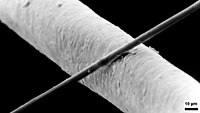
Photo from wikipedia
Abstract Reliable numerical modeling of asphalt concrete (AC) is a complex problem due to a non periodic random structure of this material and a nonlinear behavior of its interacting constituents.… Click to show full abstract
Abstract Reliable numerical modeling of asphalt concrete (AC) is a complex problem due to a non periodic random structure of this material and a nonlinear behavior of its interacting constituents. Phenomena observed at the lower resolution highly influence the overall response of pavement layers made of asphalt concrete. In this paper, we focus on the selected aspects of its efficient numerical modeling using the viscoelastic Burgers material model. In this paper, we focus on two important components of the modeling process. Firstly, we present a straightforward algorithm for the random AC structure generation, which is automatically linked with the finite element (FE) mesh generation. It is based on the predefined shapes of inclusions and the relocation of nodes of the regular grid. Such an approach provides definitely coarser (but related to the microstructure) FE meshes than other ones used for this purposes. Thus, it saves a lot of computer resources at this level of the modeling process. Our next development concerns further reduction of the number of degrees of freedom (NDOF) that are necessary to tackle the heterogeneous domain. We take advantage of the multiscale finite element method (MsFEM) to solve given problems using a coarse macroscale mesh. Within its elements, we construct special shape functions of order 1, 2 or 3 revealing the complexity of the microresolution. We propose a novel extension of the linear elastic analysis to the viscoelastic one in terms of the MsFEM. Combining the aforementioned approaches, we provide a versatile tool for the numerical modeling of asphalt concrete. The proposed framework is illustrated with the examples of the special shape function constructions and the solutions to the compression tests of the samples made of AC. Obtained results confirm the efficiency and applicability of the proposed methodology.
Journal Title: Finite Elements in Analysis and Design
Year Published: 2020
Link to full text (if available)
Share on Social Media: Sign Up to like & get
recommendations!